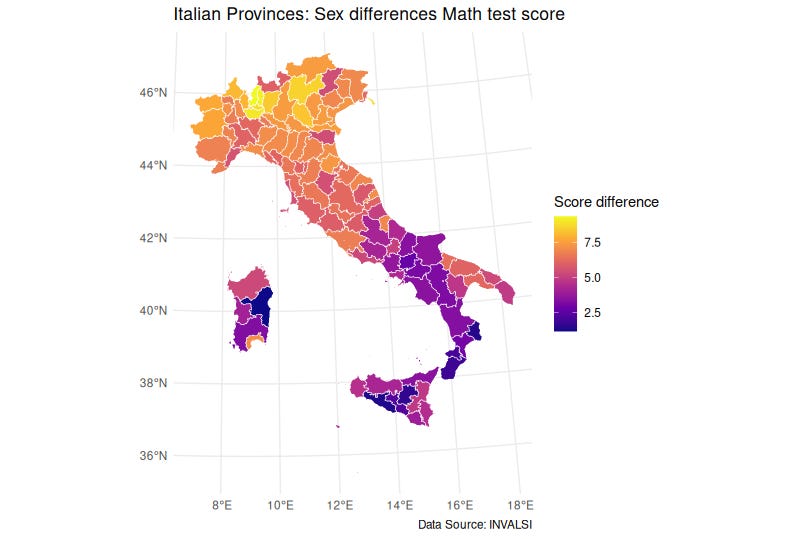Italy’s STEM Gender Gap Isn’t What You Think: Why Top-Performing Regions Have More Male Dominance
If stereotypes and bad schools caused the STEM gender gap, Italy’s wealthiest, highest-scoring provinces should have near-parity. Instead, they show the largest male advantage.
The Paradox: Better Schools, Bigger Gaps
Italy’s national discourse (for example this article: https://invalsiopen.it/stem-differenze-genere/, and many similar ones) blames the STEM gender gap on three factors:
Stereotype threat (cultural bias discouraging girls)
Poor teaching (rigid, uninspiring STEM education)
Socioeconomic barriers (fewer resources for girls)
Yet the evidence flips this logic:
Provincial math scores (PISA, INVALSI): Northern regions like Lombardy and Veneto outperform the South in student achievement.
Quality of life (ISTAT): These regions also rank highest in wealth, school funding, and gender equality metrics (e.g., female workforce participation).
The gap widens: In these high-performing areas, male dominance in standardized MATH tests grows, more so than on tests of reading.
INVALSI Data Confirms: Higher Math Scores Predict Larger Gender Gaps—And It’s Not About Geography
To further test whether Italy’s STEM gender gap aligns with the "gender-equality paradox" seen in PISA data, I analyzed INVALSI math and reading scores across Italian provinces. The results challenge conventional explanations about culture or school quality.
There is a strong correlation between latitude and both the male advantage in Math (r=0.81) and the overall student performance (r=0.87). Moreover, Math score had a strong correlation (r= 0.8) with the male advantage in Math.
Regression results:
Latitude (β = 0.248) → Marginally significant (Northern provinces show slightly larger gaps after accounting for overall Math score) .
Math Score (β = 0.495) → Remains significant after controlling for latitude.
Interpretation: While the North-South divide exists, math performance is the stronger driver of the gap. This mirrors PISA’s finding that advanced economies see bigger disparities.
2. Reading Scores: A Telling Contrast
No such pattern exists for reading. Girls outperform boys nationwide (INVALSI 2022: +12 points), but:
The gap is uncorrelated with average reading scores (high/low-performing regions show similar female advantages).
Latitude is correlated to overall reading performance but has no impact on the gender gap.
If "school quality" or "stereotypes" caused gaps, we’d expect reading gaps to vary regionally too. They don’t.
3. What This Means
Math gaps aren’t about "bias" or "bad schools." If they were:
The South’s lower-performing schools would have larger gaps (they don’t).
Reading gaps would follow similar regional trends (they don’t).
If “bad schools” or “traditional gender roles” were the culprit, the South’s underfunded classrooms and more conservative norms should favor boys most. The opposite is true.
The Widening Math Gap: Nature, Nurture, or Both?
Key Finding: As Italian students progress through school, the gender gap in math and reading grows larger.





